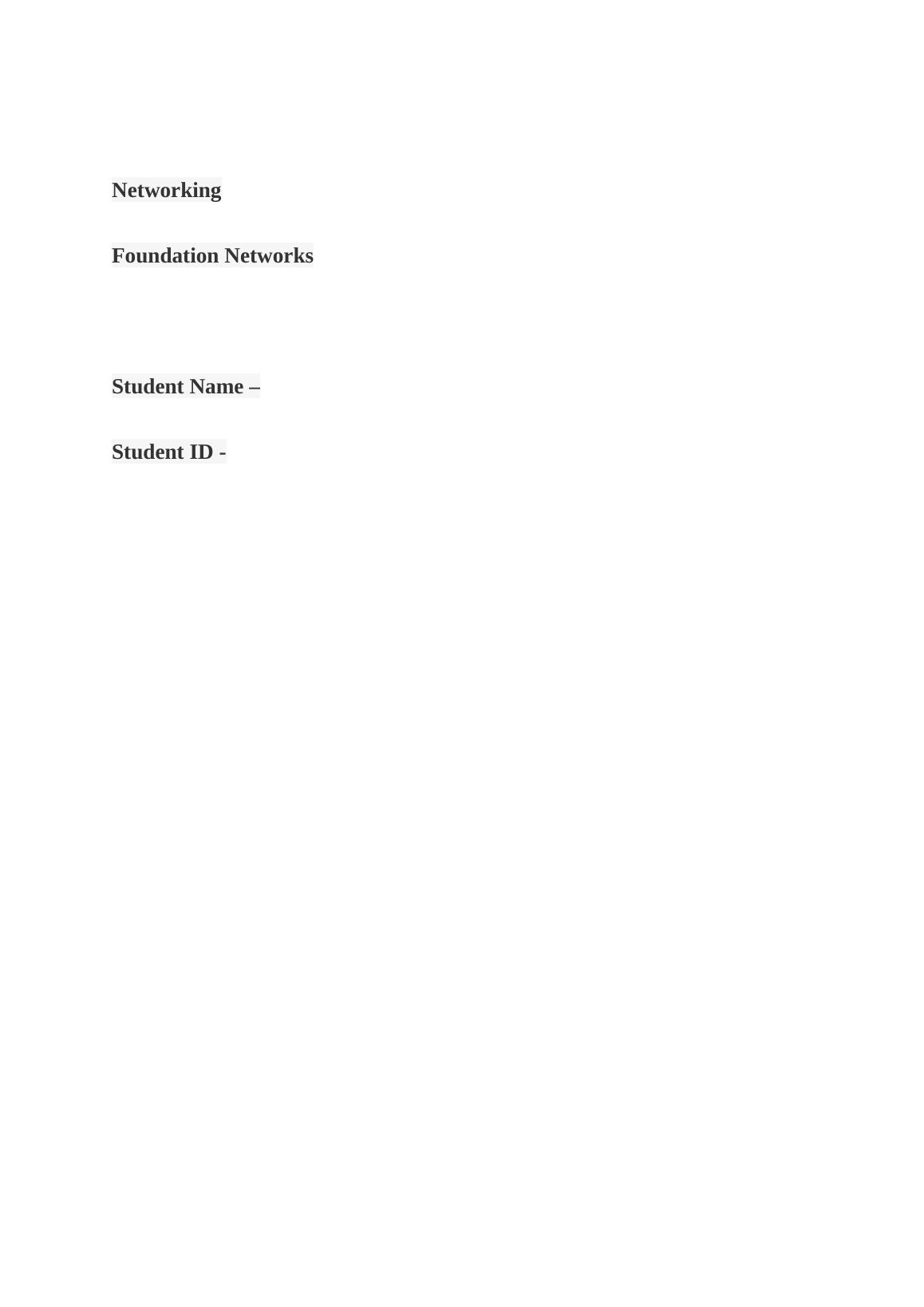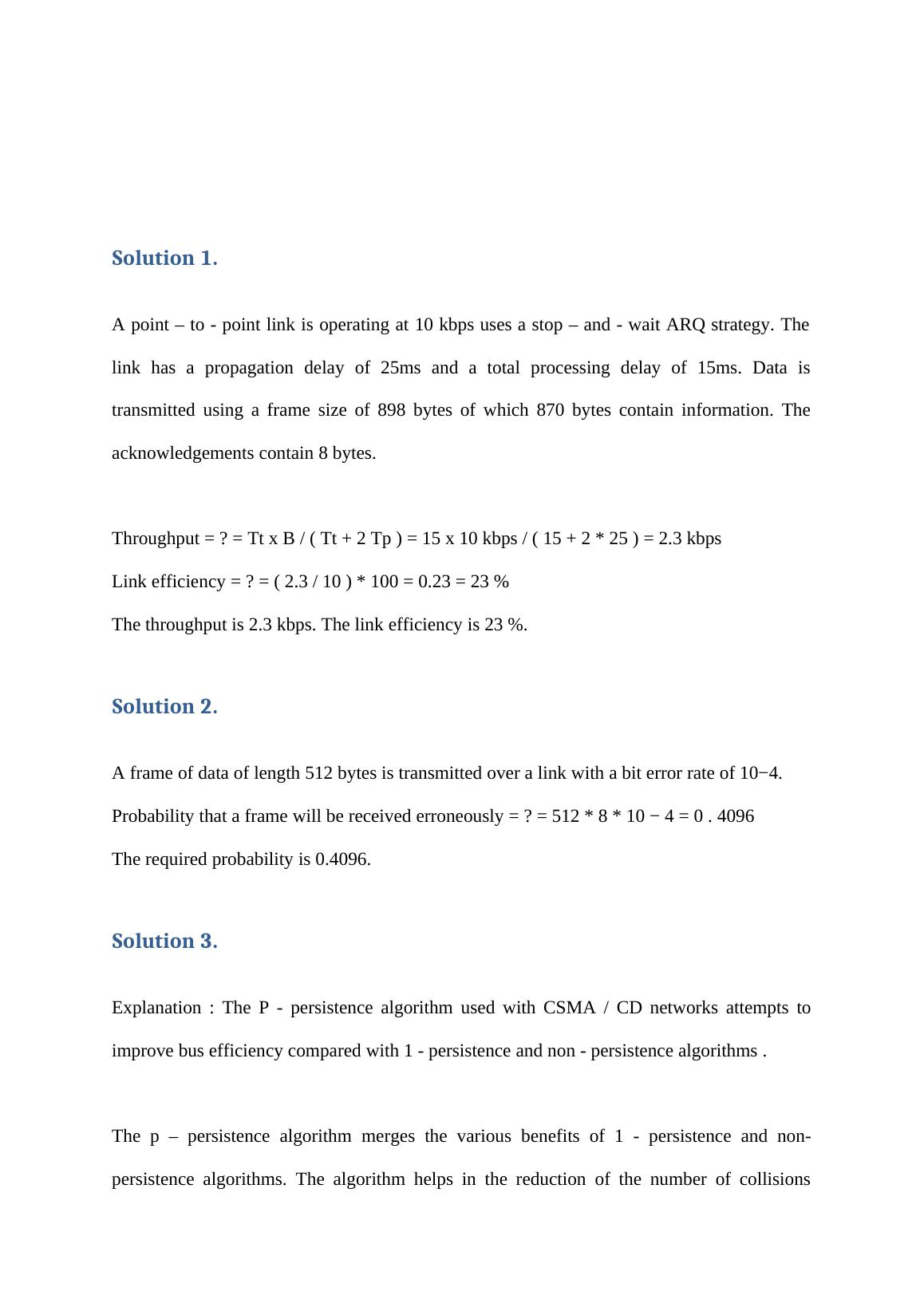Networking Foundation Networks Solutions
Added on 2022-10-02
6 Pages1096 Words348 Views
Networking
Foundation Networks
Student Name –
Student ID -
Foundation Networks
Student Name –
Student ID -

Solution 1.
A point – to - point link is operating at 10 kbps uses a stop – and - wait ARQ strategy. The
link has a propagation delay of 25ms and a total processing delay of 15ms. Data is
transmitted using a frame size of 898 bytes of which 870 bytes contain information. The
acknowledgements contain 8 bytes.
Throughput = ? = Tt x B / ( Tt + 2 Tp ) = 15 x 10 kbps / ( 15 + 2 * 25 ) = 2.3 kbps
Link efficiency = ? = ( 2.3 / 10 ) * 100 = 0.23 = 23 %
The throughput is 2.3 kbps. The link efficiency is 23 %.
Solution 2.
A frame of data of length 512 bytes is transmitted over a link with a bit error rate of 10−4.
Probability that a frame will be received erroneously = ? = 512 * 8 * 10 − 4 = 0 . 4096
The required probability is 0.4096.
Solution 3.
Explanation : The P - persistence algorithm used with CSMA / CD networks attempts to
improve bus efficiency compared with 1 - persistence and non - persistence algorithms .
The p – persistence algorithm merges the various benefits of 1 - persistence and non-
persistence algorithms. The algorithm helps in the reduction of the number of collisions
A point – to - point link is operating at 10 kbps uses a stop – and - wait ARQ strategy. The
link has a propagation delay of 25ms and a total processing delay of 15ms. Data is
transmitted using a frame size of 898 bytes of which 870 bytes contain information. The
acknowledgements contain 8 bytes.
Throughput = ? = Tt x B / ( Tt + 2 Tp ) = 15 x 10 kbps / ( 15 + 2 * 25 ) = 2.3 kbps
Link efficiency = ? = ( 2.3 / 10 ) * 100 = 0.23 = 23 %
The throughput is 2.3 kbps. The link efficiency is 23 %.
Solution 2.
A frame of data of length 512 bytes is transmitted over a link with a bit error rate of 10−4.
Probability that a frame will be received erroneously = ? = 512 * 8 * 10 − 4 = 0 . 4096
The required probability is 0.4096.
Solution 3.
Explanation : The P - persistence algorithm used with CSMA / CD networks attempts to
improve bus efficiency compared with 1 - persistence and non - persistence algorithms .
The p – persistence algorithm merges the various benefits of 1 - persistence and non-
persistence algorithms. The algorithm helps in the reduction of the number of collisions

occurring in comparison with the 1 - persistence CSMA. As compared to the non –
persistence CSMA, the channel utilization is good in this algorithm. In this algorithm, if a
transmission station wants to send a frame and finds that the channel is busy, then it will wait
till the transmission ends. After this happens, it transmits the frame having the probability ‘ p
’.
Solution 4.
A CSMA / CD - based LAN operates at 100 Mbps with a utilization of 40 %.
a. The number of information bits transmitted per second = ? = 0.6 * 100 = 60 Mbits
b. The frame length is 800 bytes of which 750 convey data
The number of frame transmitted within 4 second = ? = 60 Mbits * 4 / 800 * 8 = 37500
Solution 5. “ 5 – 4 - 3 Rule ”
This rule is used for dividing the network. It states that there can be maximum 5 segments
present between 2 given nodes in a network. They can be connected by 4 repeaters /
concentrators. Out of the 5 segments , only 3 segments can have user connections. The rule is
a design method for the Ethernet computer network ( IEEE way ).
persistence CSMA, the channel utilization is good in this algorithm. In this algorithm, if a
transmission station wants to send a frame and finds that the channel is busy, then it will wait
till the transmission ends. After this happens, it transmits the frame having the probability ‘ p
’.
Solution 4.
A CSMA / CD - based LAN operates at 100 Mbps with a utilization of 40 %.
a. The number of information bits transmitted per second = ? = 0.6 * 100 = 60 Mbits
b. The frame length is 800 bytes of which 750 convey data
The number of frame transmitted within 4 second = ? = 60 Mbits * 4 / 800 * 8 = 37500
Solution 5. “ 5 – 4 - 3 Rule ”
This rule is used for dividing the network. It states that there can be maximum 5 segments
present between 2 given nodes in a network. They can be connected by 4 repeaters /
concentrators. Out of the 5 segments , only 3 segments can have user connections. The rule is
a design method for the Ethernet computer network ( IEEE way ).

End of preview
Want to access all the pages? Upload your documents or become a member.
Related Documents
Local Area Networking Technologies PDFlg...
|8
|2286
|116
Foundation of Network 13lg...
|12
|1155
|380
Network of Foundations Working for Developmentlg...
|10
|1219
|16
